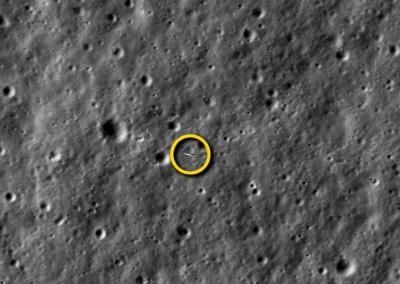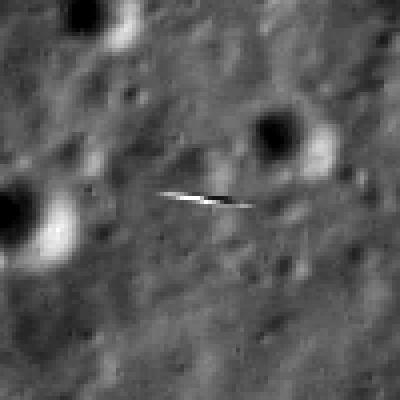Mon, Feb 03, 2014
Each Spacecraft Orbiting The Moon At 3,600 Miles Per Hour
With precise timing, the camera aboard NASA's Lunar Reconnaissance Orbiter (LRO) was able to take a picture of NASA's Lunar Atmosphere and Dust Environment Explorer (LADEE) spacecraft as it orbited our nearest celestial neighbor. The Lunar Reconnaissance Orbiter Camera (LROC) operations team worked with its LADEE and LRO operations counterparts to make the imaging possible.

LADEE is in an equatorial orbit (east-to-west) while LRO is in a polar orbit (south-to-north). The two spacecraft are occasionally very close and on Jan. 15, 2014, the two came within 5.6 miles of each other. As LROC is a push-broom imager, it builds up an image one line at a time, so catching a target as small and fast as LADEE is tricky. Both spacecraft are orbiting the moon with velocities near 3,600 mph, so timing and pointing of LRO must be nearly perfect to capture LADEE in an LROC image.
LADEE passed directly beneath the LRO orbit plane a few seconds before LRO crossed the LADEE orbit plane, meaning a straight down LROC image would have just missed LADEE. The LADEE and LRO teams worked out the solution: simply have LRO roll 34 degrees to the west so the LROC detector (one line) would be in the right place as LADEE passed beneath.
As planned at 2211 EST on Jan. 14, 2014, LADEE entered LRO’s Narrow Angle Camera (NAC) field of view for 1.35 milliseconds and a smeared image of LADEE was snapped. LADEE appears in four lines of the LROC image, and is distorted right-to-left. What can be seen in the LADEE pixels in the NAC image?

Step one is to minimize the geometric distortion in the smeared lines that show the spacecraft. However, in doing so the background lunar landscape becomes distorted and unrecognizable. The scale (dimension) of the NAC pixels recording LADEE is 3.5 inches, however, as the spacecraft were both moving about 3,600 mph the image is blurred in both directions by around 20 inches. So the actual pixel scale lies somewhere between 3.5 inches and 20 inches. Despite the blur it is possible to find details of the spacecraft, which is about 4.7 feet wide and 7.7 feet long. The engine nozzle, bright solar panel and perhaps a star tracker camera can be seen, especially if you have a correctly oriented schematic diagram of LADEE for comparison.
(Images provided by NASA. Comparison schematic not available)
More News
With Testing Soon Complete, Launch Preparations Begin in Earnest Sierra Space's Dream Chaser has been put through the wringer at NASA's Glenn Armstrong Test Facility in Ohio, but w>[...]
Takeoff Roll The process whereby an aircraft is aligned with the runway centerline and the aircraft is moving with the intent to take off. For helicopters, this pertains to the act>[...]
“We’re proud of the hard work that went into receiving this validation, and it will be a welcome relief to our customers in the European Union. We couldn’t be mor>[...]
"Aircraft Spruce is pleased to announce the acquisition of the parts distribution operations of Wag-Aero. Wag-Aero was founded in the 1960’s by Dick and Bobbie Wagner in the >[...]
IDENT Feature The special feature in the Air Traffic Control Radar Beacon System (ATCRBS) equipment. It is used to immediately distinguish one displayed beacon target from other be>[...]
 Sierra Space Repositions Dream Chaser for First Mission
Sierra Space Repositions Dream Chaser for First Mission ANN's Daily Aero-Term (05.10.24): Takeoff Roll
ANN's Daily Aero-Term (05.10.24): Takeoff Roll Aero-News: Quote of the Day (05.10.24)
Aero-News: Quote of the Day (05.10.24) Aero-News: Quote of the Day (05.11.24)
Aero-News: Quote of the Day (05.11.24) ANN's Daily Aero-Term (05.11.24): IDENT Feature
ANN's Daily Aero-Term (05.11.24): IDENT Feature




